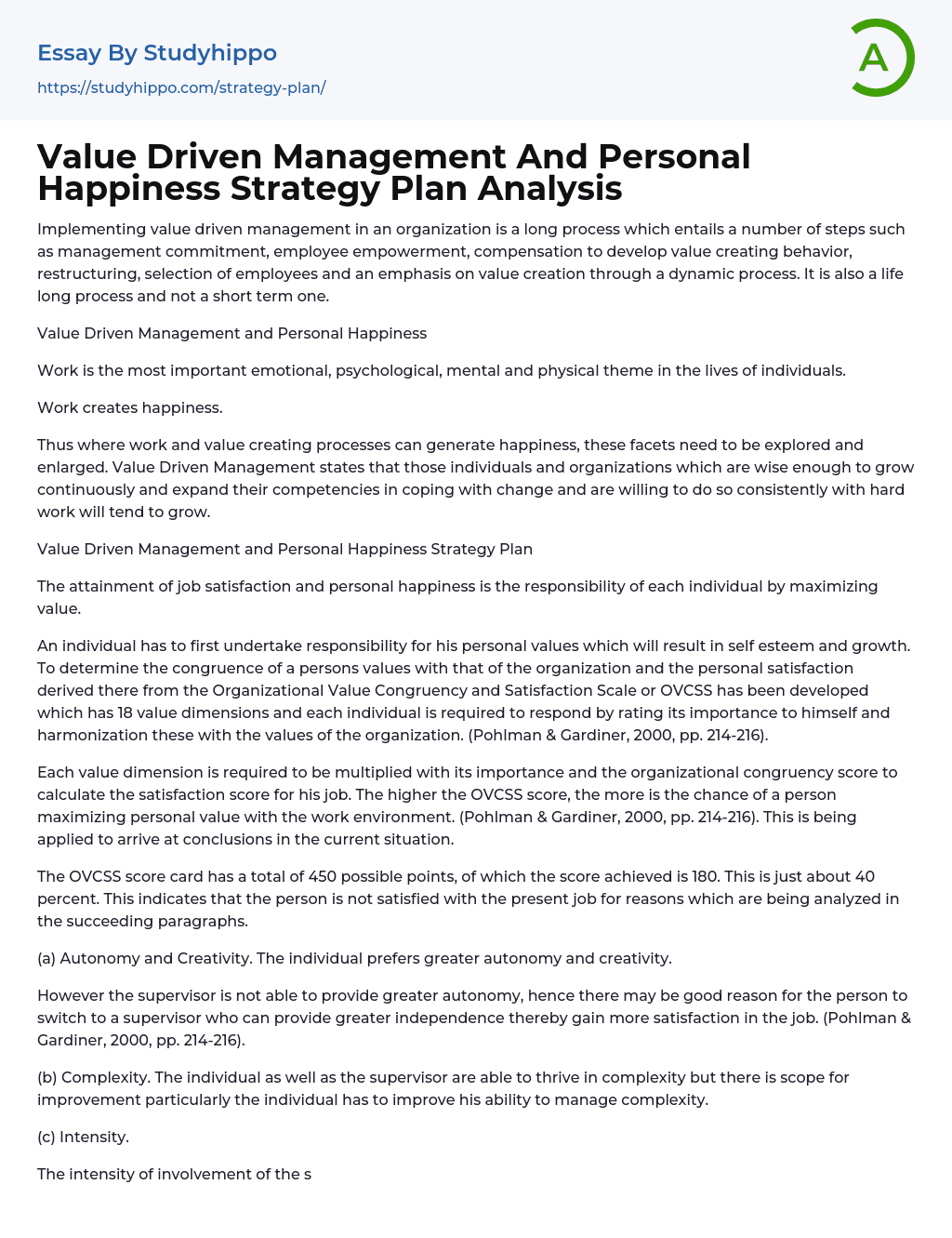

Value Driven Management And Personal Happiness Strategy Plan Analysis Essay Example
Implementing value driven management in an organization is a long process which entails a number of steps such as management commitment, employee empowerment, compensation to develop value creating behavior, restructuring, selection of employees and an emphasis on value creation through a dynamic process. It is also a life long process and not a short term one.
Value Driven Management and Personal Happiness
Work is the most important emotional, psychological, mental and physical theme in the lives of individuals.
Work creates happiness.
Thus where work and value creating processes can generate happiness, these facets need to be explored and enlarged. Value Driven Management states that those individuals and organizations which are wise enough to grow continuously and expand their competencies in coping with change and are willing to do so consistently with hard work will t
...end to grow.
Value Driven Management and Personal Happiness Strategy Plan
The attainment of job satisfaction and personal happiness is the responsibility of each individual by maximizing value.
An individual has to first undertake responsibility for his personal values which will result in self esteem and growth. To determine the congruence of a persons values with that of the organization and the personal satisfaction derived there from the Organizational Value Congruency and Satisfaction Scale or OVCSS has been developed which has 18 value dimensions and each individual is required to respond by rating its importance to himself and harmonization these with the values of the organization. (Pohlman & Gardiner, 2000, pp. 214-216).
Each value dimension is required to be multiplied with its importance and the organizational congruency score to calculate the satisfactio
score for his job. The higher the OVCSS score, the more is the chance of a person maximizing personal value with the work environment. (Pohlman & Gardiner, 2000, pp. 214-216). This is being applied to arrive at conclusions in the current situation.
The OVCSS score card has a total of 450 possible points, of which the score achieved is 180. This is just about 40 percent. This indicates that the person is not satisfied with the present job for reasons which are being analyzed in the succeeding paragraphs.
(a) Autonomy and Creativity. The individual prefers greater autonomy and creativity.
However the supervisor is not able to provide greater autonomy, hence there may be good reason for the person to switch to a supervisor who can provide greater independence thereby gain more satisfaction in the job. (Pohlman & Gardiner, 2000, pp. 214-216).
(b) Complexity. The individual as well as the supervisor are able to thrive in complexity but there is scope for improvement particularly the individual has to improve his ability to manage complexity.
(c) Intensity.
The intensity of involvement of the supervisor is low. This factor needs to be reconciled. (Pohlman & Gardiner, 2000, pp. 214-216)
(d) Status. The supervisor is not able to score on status, while the individual is concerned about the same. Thus again it is essential that there is a greater alignment between the two.
(Pohlman & Gardiner, 2000, pp. 214-216)
(e) Precision. The individual has a high score on precision but the supervisor is not able to provide him the desired impetus for growth.
(f) Competition. The supervisor is a competitive person, but the
individual is low on competitiveness. Since this is essential to sustain business the individual must improve his competitive skills.
(Pohlman & Gardiner, 2000, pp. 214-216).
(g) Physical, Outdoor Work, Travel and Routine. In these value dimensions, the individual has scored poorly.
This is obviously denoting that there is a requirement for him to devote attention to outdoor work and also routine to which he is not fully attuned. This needs to be improved or he may seek an indoor job which will provide greater satisfaction. (Pohlman & Gardiner, 2000, pp. 214-216)
(h) Security.
This is a median score for both and thus an indicator of the need to improve.
(j) People and Team Orientation. People and team orientation is relatively high in the individual but low for the supervisor. Switching supervisors may be one solution.
(k) Leadership, Authority and Responsibility. The scores are reasonably high for the individual, but lower for the supervisor.
(l) Industry Image. The score is very high for the supervisor and low for the individual.
Thus there is a need for him to build a greater alignment towards the industry. (Pohlman & Gardiner, 2000, pp. 214-216).
- Competition essays
- Effective Leadership essays
- Leadership Styles essays
- Public relations essays
- Planning essays
- Mission Statement essays
- Outsourcing essays
- Swot Analysis essays
- Business Analysis essays
- Business Plan essays
- Strategic Management essays
- Strategic Planning essays
- Reasoning essays
- Community Development essays
- Negotiation essays
- Aesthetics essays
- Art History essays
- Artist essays
- ballet essays
- Body Art essays
- Color essays
- Concert Review essays
- Creativity essays
- Cultural Anthropology essays
- Ethnography essays
- Harlem Renaissance essays
- Heritage essays
- Modernism essays
- Mona Lisa essays
- Pastoral essays
- Postmodernism essays
- Realism essays
- Symbolism essays
- Theatre essays
- Visual Arts essays
- Voice essays
- Work of art essays
- Ambition essays
- Anger essays
- Betrayal essays
- Boredom essays
- Confidence essays
- Courage essays
- Desire essays
- Disgrace essays
- Doubt essays
- Empathy essays
- Fairness essays
- Fear essays
- Feeling essays



